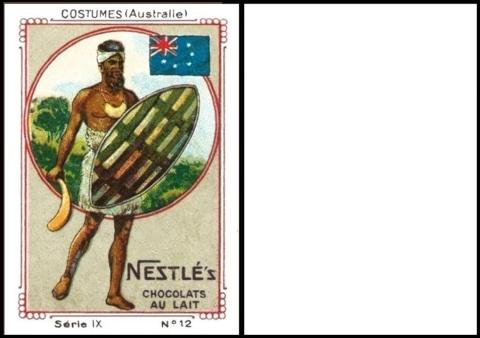
This Australian dates from a time before his land and language was taken away. Many languages were spoken before the invaders came, it is estimated that over two hundred and fifty different tongues, and as many as eight hundred regional dialects were heard across the land.
Today there are but a hundred and twenty three which have managed to survive, and over a hundred of those are on the list of seriously endangered languages. Efforts are ongoing to record them, but so many have been lost, and many of the ones which somehow survived are simply just a few words, with no connection to other languages, and no stories about from where they came.
Some of the work to restore the lost is detailed at AIATSIS, a truly fascinating site, and not a commercial one dragged from other sites, this carries the voices and words of the Aboriginal and Torres Strait Islanders themselves. And the work they do in all areas of making sure these people are not forgotten is quite amazing.
As this seems to be the first time we have shown a purely "Nestle" branded one of these little paper stamps, we ought to tell the story of Nestle too. Nestle was a person before a brand, a Heinrich Nestle, born on the 10th of August 1814, in Frankfurt am Main, Germany, and one of fourteen children. It is often reported that he was a glazier by trade, but not so frequently that one of his brothers became the Lord Mayor of his birthplace, nor that several members of the Nestle family tree were also mayors of other towns.
Nestle actually means a bird`s nest, usually one of the smaller birds, in which the chicks keep each other warm simply by their close proximity. In fact if you look at the logo for Nestle you will see the nest, with three little chicks popping up, and this is also on their coat of arms, where tradition has it that these are the first ever Nestle children, who were born in the sixteenth century.
The Swiss connection comes in when Heinrich Nestle moved, to Switzerland, in the mid nineteenth century. We do not know why that was, only that after completing an apprenticeship with a pharmacist in his town he suddenly left and became a pharmacist in Lausanne. He also changed his name to the more French sounding Henri Nestle. He also seems to have had a little sideline in selling alcoholic and carbonated drinks. This seems to have lasted less than five years, then he started experimenting with making fertilizer, and this led him into making gas for lighting, though he had earlier also been involved with a scheme to make oil. for lamps, out of nuts.
The fertilizer and the lighting seem to have also been abruptly ended, but they were replaced with something that would make his name, and that was powdered milk, specifically for babies and infants. We do not know why he started making this, especially as he had no children, but some have suggested that he picked up on the fact that the infant mortality rate was rather alarming, and thought there would be a market for a product that offered to reduce this.
The odd fact is that when he was making his fertilizer he had come across a man called Justus von Liebig, who was also working with fertilizers, but at the same time had developed a way to extract the nourishment of beef into a liquid form. Now the two men would enter each other`s arena again, for Liebig marketed his beef extract primarily as a health food for infants and babies. However, the nature of Liebig`s product meant that it was harder to prepare, and was not always digestible, especially if not served correctly. Maybe Nestle heard of this and that was the spur. Nestle based his not on beef, but on cow`s milk, wheat, and sugar, though he removed the wheat starch. He called his product "Farine Lactee Henri Nestle" (wheat milk by Henri Nestle).
This was an immediate sensation, across the globe. However it also led to a new partnership, for it was his process for making condensed milk that was the key to the production of milk chocolate, by Daniel Peter, in 1875. And we will pick up the Peter story on another page - some time.
As far as our set, here is a list of all the cards
- Egypte - [Egypt]
- Turquie - [Turkey]
- Indes - [India]
- Chine - [China]
- Algerie - [Algeria]
- Etats Unis - [United States of America]
- Bresil - [Brazil]
- Mexique - [Mexico]
- Japan - [Japan]
- Canada - [Canada]
- Conge - [Congo]
- Australie - [Australia]
But do be aware that this set was also issued by Peter, Cailler, Kohler, Nestle. They bear all those makers names, not just Nestle alone, but these fill the top border, whereas our set just has "Costumes" and the name of the country shown. Also be careful in another way, as there are several versions - all the pictures of which are identical to ours, just numbered either as "Serie XVIII", "Serie 18" or as "Serie 18" with a "B" in the centre of the bottom border. The only versions I have not seen in all three versions are
- 9. Japan as an 18.B
- 11. Congo as an XVII
- 12,. Australia as an 18.B
And there is also a set that looks almost identical but is only costumes of European countries, that is Serie XIX.
